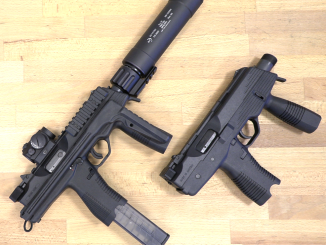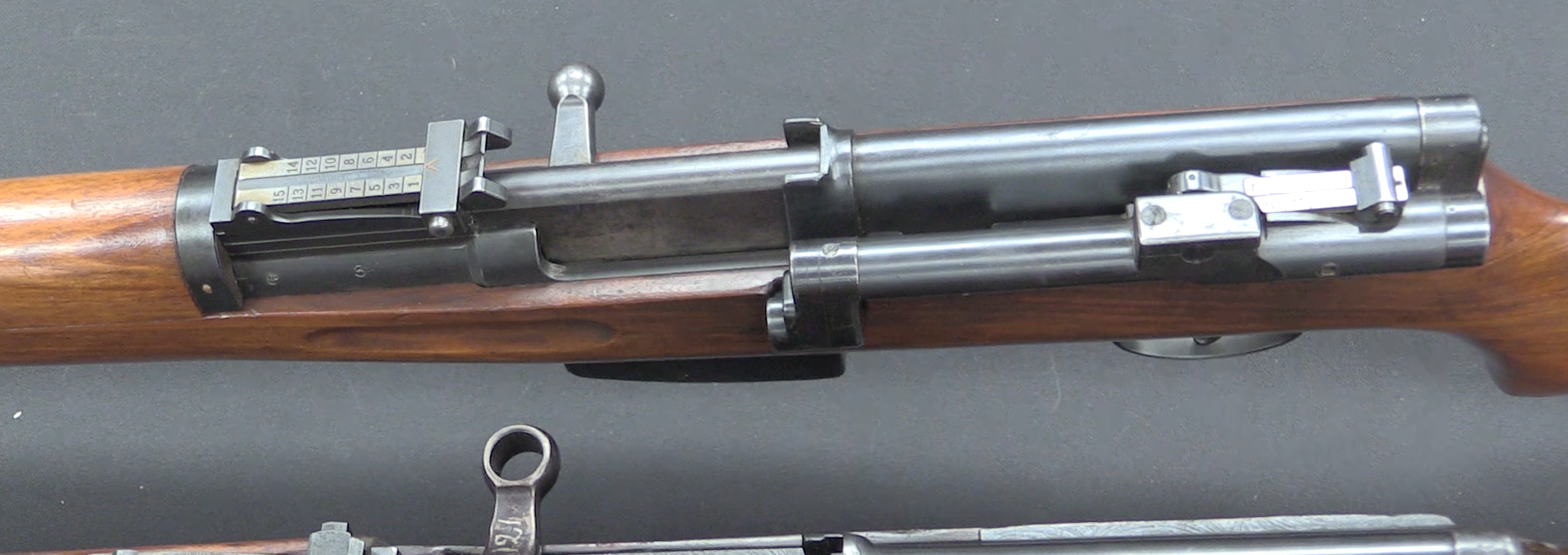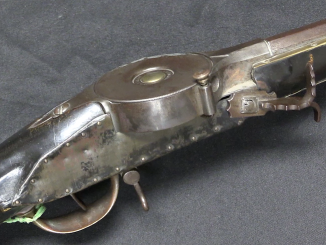Switzerland was the First Nation to adopt the Luger as a service pistol, and they purchased them DWM in Germany from 1900 until 1914. World War One stopped deliveries, of course, and after the war the Swiss opted to begin their own production at Waffenfabrik Bern. These Swiss Lugers have become known as the model 06/24 by collectors, and were made until 1933. During that time, Bern was looking for ways to simplify and economize their production, and these efforts came together with the development of the Model 1929. It actually entered production in 1934, and was made until 1947 with a total of about 28,000 made for the military and about 1,900 made for the civilian market.
The main mechanical change to the 1929 pattern was a lengthening of the grip safety. Other changes included simplifying the profile of the front strap of the grip, removing knurling and serrations on the controls, and only serializing four parts. A production date stamp was also added to the inside of the frame, however.




re:
“Swiss 1929 Simplified Luger (Yes, Swiss and Simplified)”
Ian, you owe me a new keyboard and a diet dr pepper.
“It actually entered production in 1934, and was made until 1947 with a total of about 28,000 made for the military and about 1,900 made for the civilian market.”
What is quite mind boggling for me is that they decided to also redesign their Revolver Modell 1882 which resulted in Revolver Modell 1882/29 and was produced until end of Second World War. https://de.wikipedia.org/wiki/Revolver_Modell_1882,_1882/29
Does anybody know reason for that decision (producing both simplified automatic pistol and simplified revolver)? It is said that revolver 1882 costed 120 and revolver 1882/29 costed 90, but what was cost of 1929 Swiss Parabellum?
I don’t know, but perhaps the issue was a lack of tooling for newer designs. The Swiss were not in a position to make radical changes to existing tools and infrastructure during the depression years, if the use of electrically heated steam locomotives indicates anything. I could be wrong.
” during the depression years, if the use of electrically heated steam locomotives indicates anything”
If you are thinking about E 3/3 8521 or E 3/3 8522 then their usage (in electrically-heated form) started in 1943 year according to:
https://en.wikipedia.org/wiki/Electric-steam_locomotive
due to on-going situation in Europe, which limited Swiss possibilities in area of coal import.
Such solution was proposed as early as 1904, see 1st image from top:
http://www.douglas-self.com/MUSEUM/LOCOLOCO/swisselec/swisselc.htm
but beyond that Swiss locomotives it remained only theoretical. Also note that in Switzerland 2 (two) locomotives were converted in such way, which is hinting that “ok, lets look well it would work” with answer apparently being that “we do not more such locomotives”.
I’m not sure about limitations on Swiss locomotive tech and production.
The Swiss were the first to put gas turbine locos into service, with a Brown et Boveri, between the wars that less enlightenment nations got mixed up in.
Are we looking at a way to retain the useful characteristics of steam locos (eg, setting off with maximum torque from zero revs) and using Swiss resources (eg hydro electric power) rather than the unavailable imported coal?
The Swiss are also a nation of mountain farmers and bankers
They are (were) both acutely aware of the time value of money. Why blow money on building new stuff if you can adapt stuff you already have that has years of life ahead of it?
Losses, losses, losses.
Note that electric locomotive has one energy conversion inside that is voltage->torque.
Electric-heated steam locomotive has two consecutive energy conversions inside: voltage->heat/pressure->torque.
None of these conversion is 100% efficient, but electric engines are (at least today, I am not sure about 1940s Swiss technology) 90% or so efficient.
Steam engines and turbines are prevented by thermodynamic to go above 63% (ABSOLUTE NO GO ZONE) and even turbines in real-life attain 40% or so, piston (or reciprocating if you wish) steam engine have even less real efficiency, additionally this particular locomotives have single expansion steam engines which are less efficient that other (double expansion) piston steam engines. Finally such solution actually combines (energy-wise) drawback of both electric locomotive (losses during energy transfer between electric plant and locomotive) and steam locomotive (relatively low efficiency).
From Bobba’s, and Simoni’s books:
P00 DWM – 400 frs
P06/24 W+F – 225 frs
P06/29 W+F (with SIG frames and Hammerli barrels) – 170 frs to 160 frs
The revolver was kept in production as it was a national product, still cheaper than the P06/29. There weren’t enough Parabellums to fill the needs of the Army too.
On a side note: on the italian and swiss market, Swiss Lugers were always more in demand than the german ones.
“P06/29 W+F (with SIG frames and Hammerli barrels) – 170 frs to 160 frs”
Uhh… that is almost two times as expensive as 1929 revolver.
“There weren’t enough Parabellums to fill the needs of the Army too.”
That explains everything.
170 Francs (https://www.historicalfirearms.info/post/156014294599/swiss-model-190629-luger-on-november-30th)
Of all the things to economize on, I would not have chosen the knurling on the toggle joints. It hardly seems like a good idea to make the pistol harder to operate.
Perhaps the user did not expect to get his hands dirty or wet.
As someone who has removed skin from my fingers doing a fast tap-rack-BANG with a P.08, I’m not so sure the smooth toggle knobs are such a bad idea.
The other simplifications are equally interesting. Note the front end of the barrel extension/upper receiver is turned round on a lathe instead of being machined with an end mill. The DWM-style machining at that point is mainly cosmetic, anyway.
The retention of the grip safety seems contradictory to the “simplification” concept, until you remember that the Swiss Luger has basically the old model (Model 1900) type searage. While noted for a better trigger pull than the P.08, the Old Model also was a bit more prone to “drop-firing” if it fell on a hard surface. The grip safety was intended as a safeguard against this, so its retention on the 06/29 makes good sense.
cheers
eon
“As someone who has removed skin from my fingers doing a fast tap-rack-BANG with a P.08, I’m not so sure the smooth toggle knobs are such a bad idea.”
On the other hand Swiss forces were excepted to often operate in frost temperatures, that is using winter gloves.
Grip Safety was retained per request of the (very influential) Cavalry.
Didn’t the Swiss use some L35 Finnish Lahtis?
In 1943, 10 Lahti pistols were exported to Switzerland for test purposes. The Swiss did not adopt the type;
https://www.jaegerplatoon.net/PISTOLS1.htm
The only foreign country to adopt the Lahti was Sweden. They actually copied it in a somewhat simplified form;
http://www.gotavapen.se/gota/m40/pist40_1.htm
cheers
eon
Finland attempted to replace the Lahti-1935 pistol with the Birger-1944 pistol but post-WW2 restrictions ended the Birger production with 25 pistols.
Personally I never thought I would add a “Luger” style pistol to my collection, but I have always appreciated its design and old world manufacturing brilliance. Then several factors came into play over the last year and the momentum towards an M29 Parabellum grew. Most notably Mr. Macullum’s brief video and the Colorado Gun Collector’s Show last week pushed me over the edge and down into the rabbit hole. One of the exhibits competing for the best in show prize was a fantastic history of the Swiss Luger. The gentleman who put it together shared a wealth of information with me and was one of four exhibitors who recommended that I visit Simpson at the show. I have done business with Simpson in the past and it was a pleasure to meet Brad and Robert at the show. Post show Brad was kind enough to pick one out of their stock for me (at a show related savings) and it should arrive at my LGS on Tuesday. For a first Luger, which will be used, as well as cared for Simpson was my best source. I am as excited as a Swiss school girl and can’t wait until Tuesday. Thanks Ian!